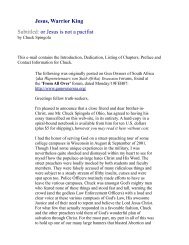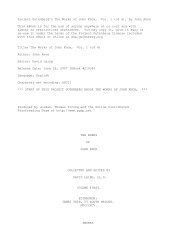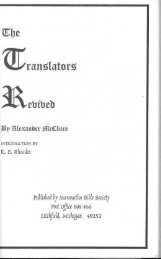THE PINK SWASTIKA - Shattering Denial
THE PINK SWASTIKA - Shattering Denial
THE PINK SWASTIKA - Shattering Denial
Create successful ePaper yourself
Turn your PDF publications into a flip-book with our unique Google optimized e-Paper software.
offer to write the foreword to Blueher’s book describing homosexuality in the Wandervoegel. Blueher<br />
writes,<br />
I was led into the study of the “Wise Man of Berlin” (as he was called)...Sitting on a silk-covered<br />
fauteuil, legs under him like a Turk, was an individual with bloated lips and cunning, dimly coveting<br />
eyes who offered me a fleshy hand and introduced himself as Dr. Hirschfeld...[Later in a meeting of the<br />
SHC] the first to greet me was a corporal with a deep bass voice; he was, however, wearing women’s<br />
clothes... “A so-called transvestite!” commented Dr. Hirschfeld, whose nickname was “Aunt<br />
Magnesia,” and introduced us...Then a most beautiful youth appeared..."A hermaphrodite!" said<br />
Hirschfeld. “Why don’t you come to me during my office hours tomorrow, you can see him naked<br />
then”...An older gentleman in his sixties...recited a poem...to a sixteen year old youth, full of<br />
yearning...I turned to Laurent, who was the only kindred spirit in this pack of lemurs, “Tell me, haven’t<br />
you noticed that we’re in a downright brothel here?” (Blueher in Mills:160f).<br />
Blueher’s disgust with Hirschfeld and the SHC was representative of the attitude of the masculine<br />
homosexual camp. But at this stage of the conflict, the “Fems” were fully in control and enjoyed what<br />
support there was in German society for the homosexual political cause. The SHC’s “scientific” focus<br />
lent an air of legitimacy to its political goals that the masculine group could not achieve. Yet it was a<br />
strategy that would ultimately backfire on the “Fems.” Sociologist David Greenberg writes that<br />
Ulrichs’ third-sex theory “was a controversial strategy among German homosexual activists; those in<br />
the anti-feminist wing of the movement viewed male homosexuality as an expression of male<br />
superiority and considered the Ulrichs-Hirschfeld position insulting” (Greenberg: 410).<br />
Hoping to use the argument that homosexuality is congenital to justify its decriminalization,<br />
Hirschfeld tried desperately to legitimize his “third-sex” theory and homosexuality generally (ibid.:<br />
410). He formed the Sex Research Institute of Berlin, which opened its doors on July 1, 1919. It’s<br />
purpose was in part to provide legal services for men arrested for violating Paragraph 175 but also to<br />
legitimize the view of homosexuality as a medical condition (Bianco:64). In that same year, Hirschfeld<br />
produced the first pro-homosexual film “Anders als die Andern” (Different from the Others) in which<br />
he appeared briefly (ibid.).<br />
The Sex Research Institute, housed in a Berlin mansion purchased by Hirschfeld, assimilated the<br />
SHC’s massive collection of books, photographs and medical documents and began a campaign to<br />
make itself “respectable” in German society. According to Plant, “attending physicians offered various<br />
kinds of sexual counseling...treated people for venereal diseases...[and gave] advice on abortion<br />
procedures.” The fact that many Nazi leaders were treated at the Sex Research Institute led the<br />
Institute’s Assistant Director, Ludwig L. Lenz, to conclude that its destruction by the Nazis in 1933 was<br />
for the purpose of destroying evidence of Nazi perversions (see above).<br />
For many years the Scientific-Humanitarian Committee was the largest and most influential<br />
homosexual organization in the German “gay rights” movement. In 1914, it had one thousand<br />
members (Steakley:60). But homosexuality in Germany was much more prevalent than the size of the<br />
membership of the SHC would suggest. Not surprisingly, one of the early goals of the SHC was to find<br />
out how many homosexuals there were in the German population. In what may have been the world’s<br />
first survey of its kind, the SHC distributed 6611 questionnaires to Berlin students and factory workers<br />
in 1903. The results were published the following year in the Jahrbuch (“Yearbook”) and showed that<br />
2.2% of the German male population admitted to being homosexual (ibid.:33).









